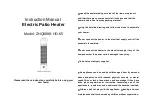
12
I-RIH (05-21) 131793-A
INSTALLATION—CONTINUED
Gas Connections—Continued
Gas Supply Line
⚠ CAUTION ⚠
• DO NOT use gas supply piping to support the heater.
• Isolate the heater from the gas supply line during high pressure leak testing of gas supply piping.
• Always use two wrenches when mating pipe connections to the heater. Excessive torque on the
manifold may misalign the gas orifices and cause the heater to malfunction.
• An agency-approved flexible connection between the supply line and the heater may be used only
if permitted by local code. It is recommended that either the piping or the mounting be flexible
to prevent fatigue failure from vibration and/or thermal expansion.
• An overpressure protection device may be required in some jurisdictions.
•
Install a 6-inch (152-mm) drip-leg trap at the inlet connection (see
) .
•
Install a 1/8-inch (32-mm) NPT plugged tap, accessible for text gauge connection immediately upstream of the
gas supply connection to the heater (see
) .
•
Test all piping joints for leaks using a non-corrosive leak detecting solution . Do not subject gas pressure regulators,
flex connectors, and gas cocks (see
) on the heater to test pressures over 14 IN WC while checking
supply piping for leaks .
•
A first-stage pressure regulator (see
) is required when gas supply pressure exceeds 14 IN (35 cm) WC .
If a pressure regulator is required, ensure that it is installed in the gas line with the arrow that indicates gas flow
pointing in the proper direction .
•
Purge all gas supply lines of air completely before attempting to ignite the heater .
•
All components upstream of the gas valve on the unit are field-supplied (see
) .
Figure 4. Gas Supply Connections
Gas
supply
Drip leg
Manual
gas valve
Pressure regulator
required when supply
pressure exceeds
14 IN (35 cm) WC
Gas cock with plugged
pressure tap (component
of the agency-approved
flexible connector shown
here)
Agency-approved flexible connector
(if permitted by local code)
Gas valve
with manifold
pressure tap










































